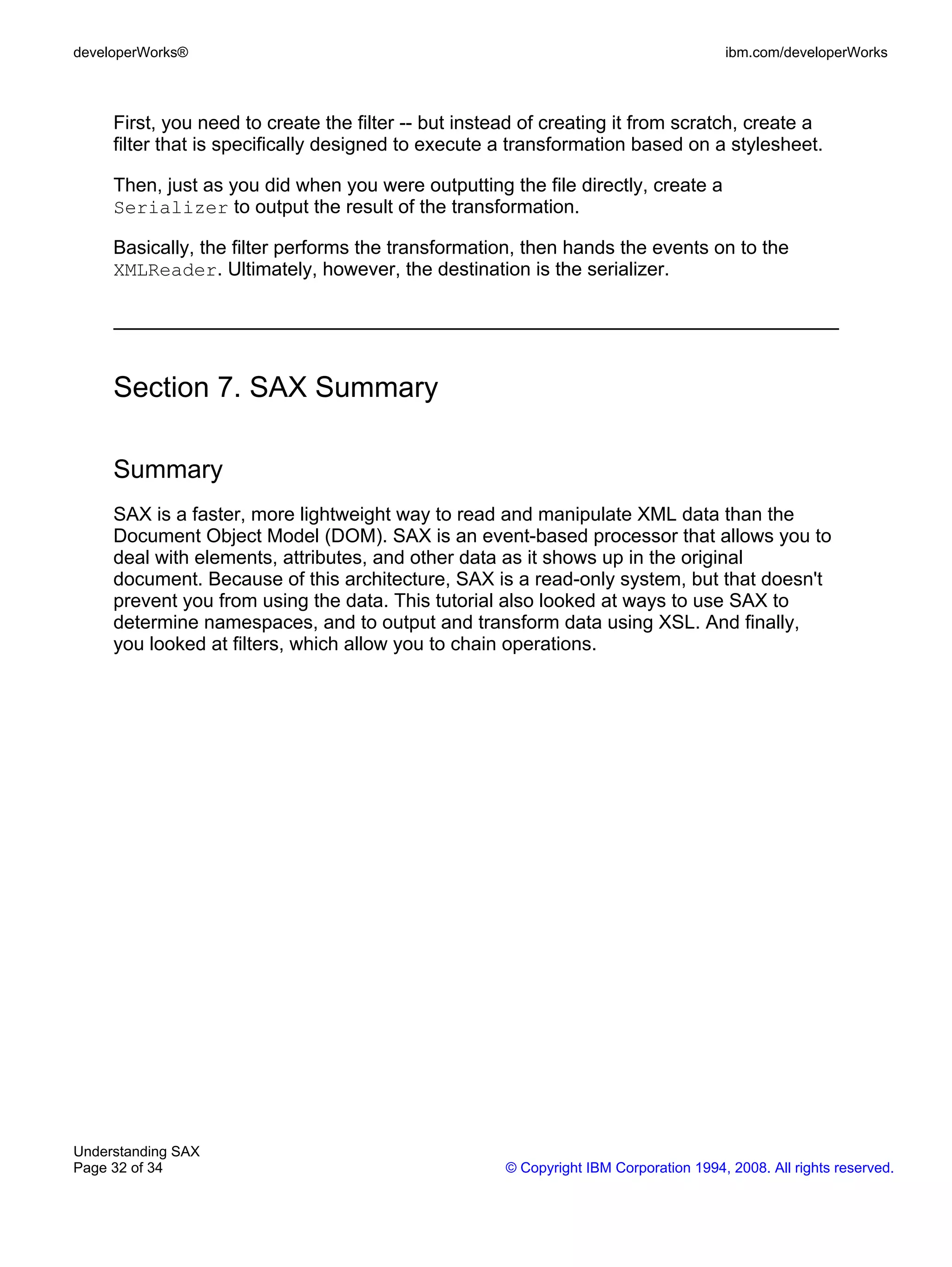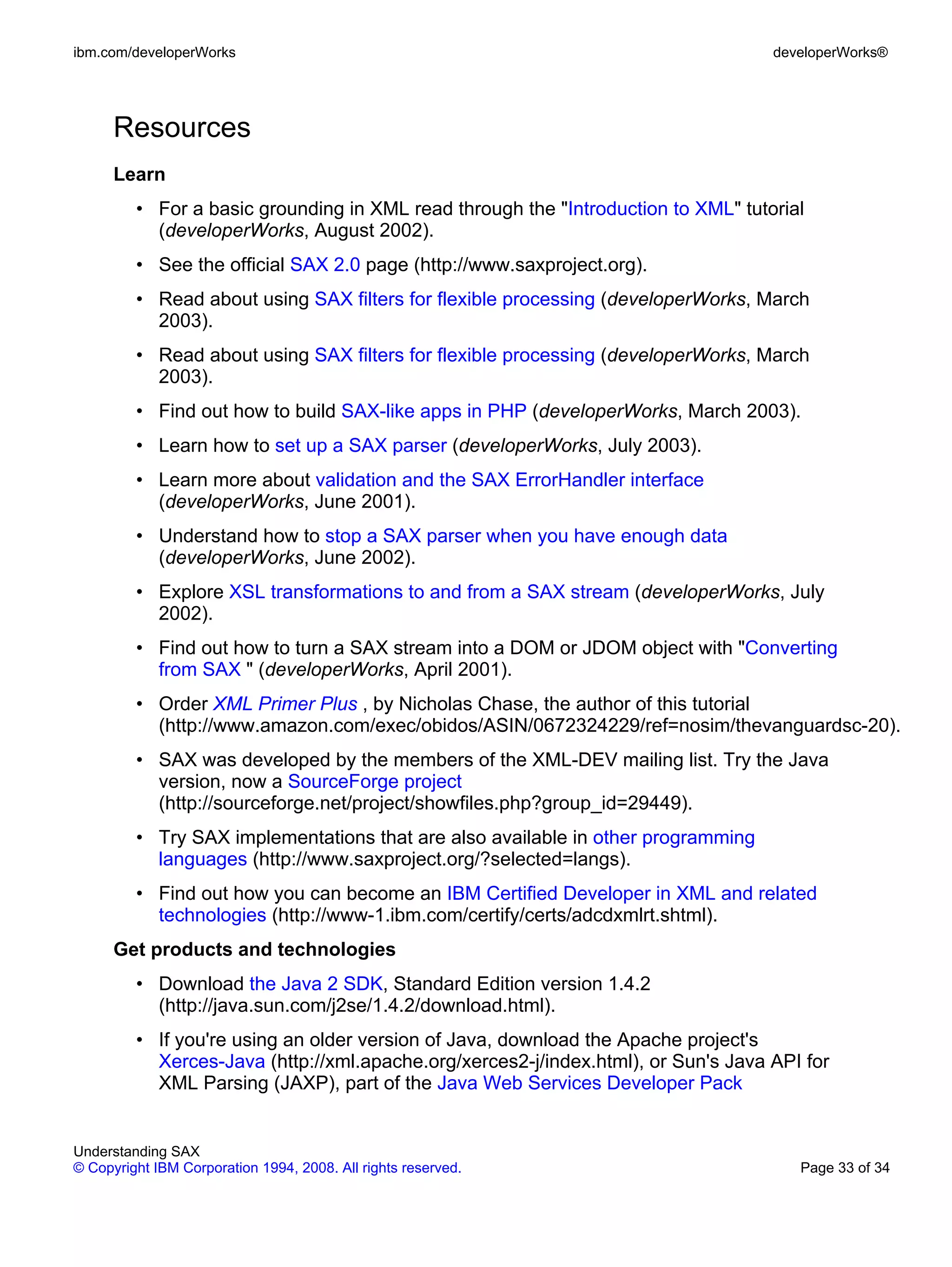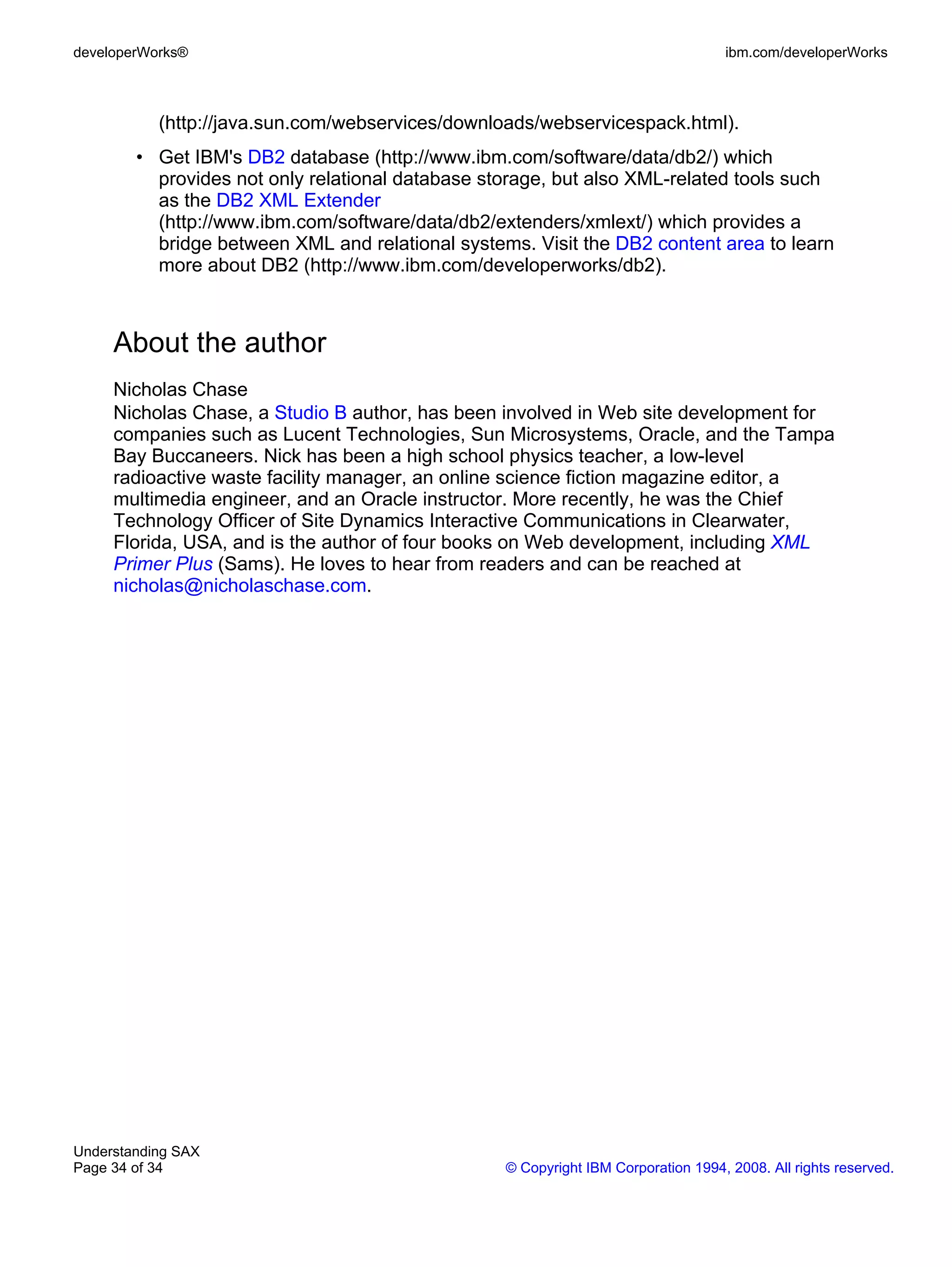This document provides an overview of SAX (Simple API for XML) and how to create a SAX parser in Java. SAX is an event-based API that allows processing XML data as it is read without loading the entire document into memory. The tutorial discusses DOM vs SAX, how SAX processing works by sending events to a handler, and the steps to create a SAX parser which include: 1) creating an event handler class, 2) creating an XMLReader using a SAX parser factory, and 3) setting the parser to be non-validating.
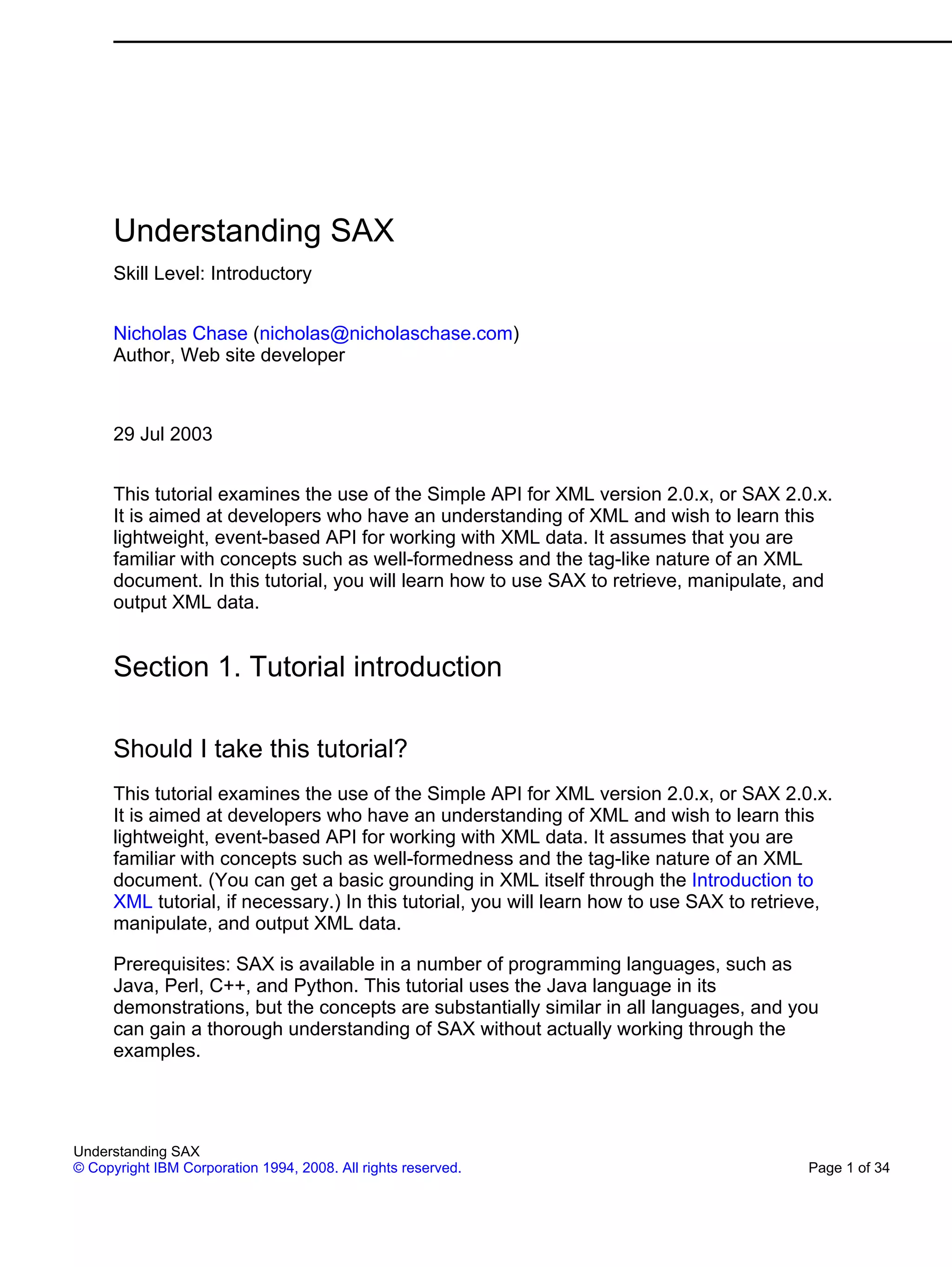
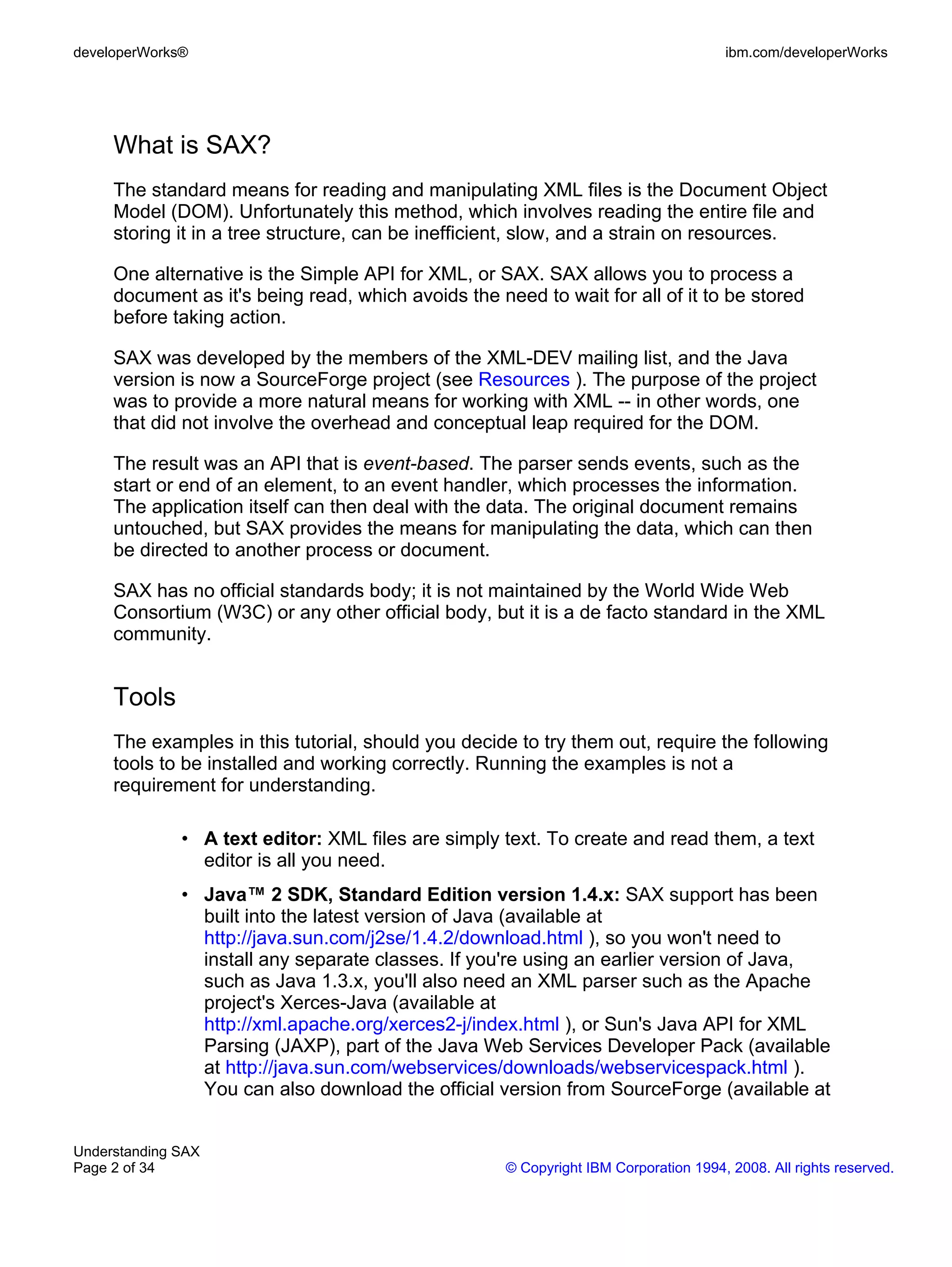
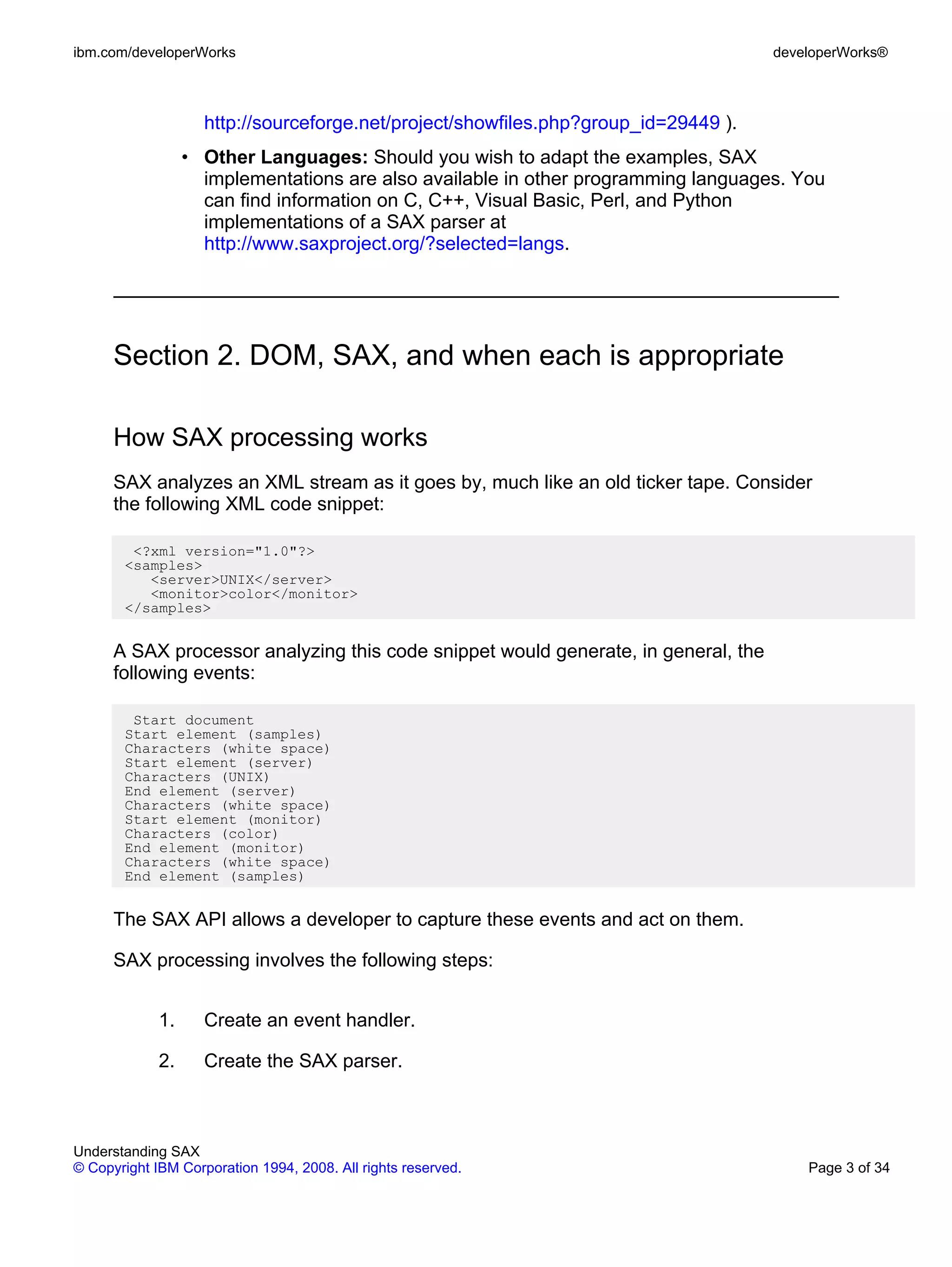
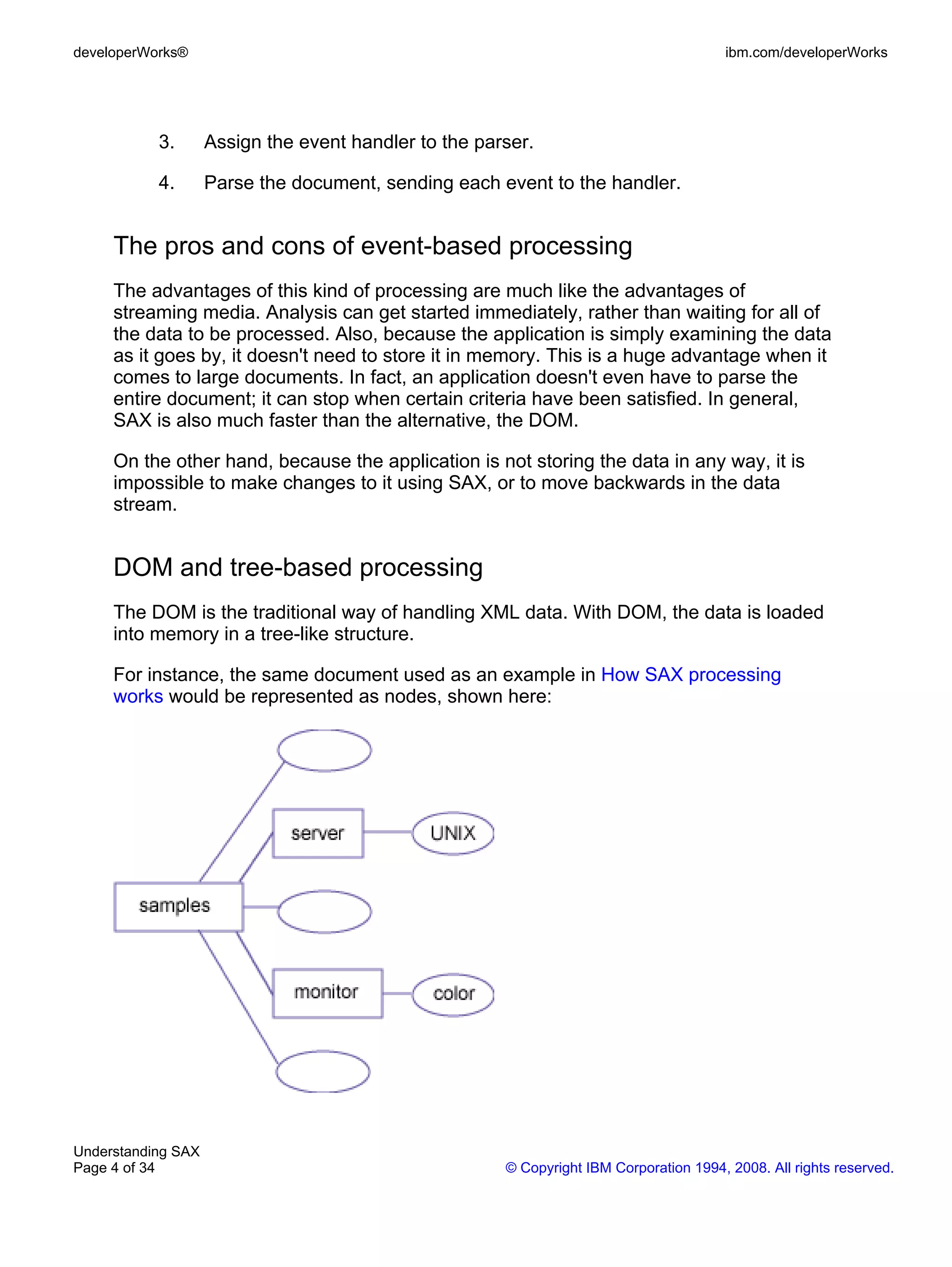
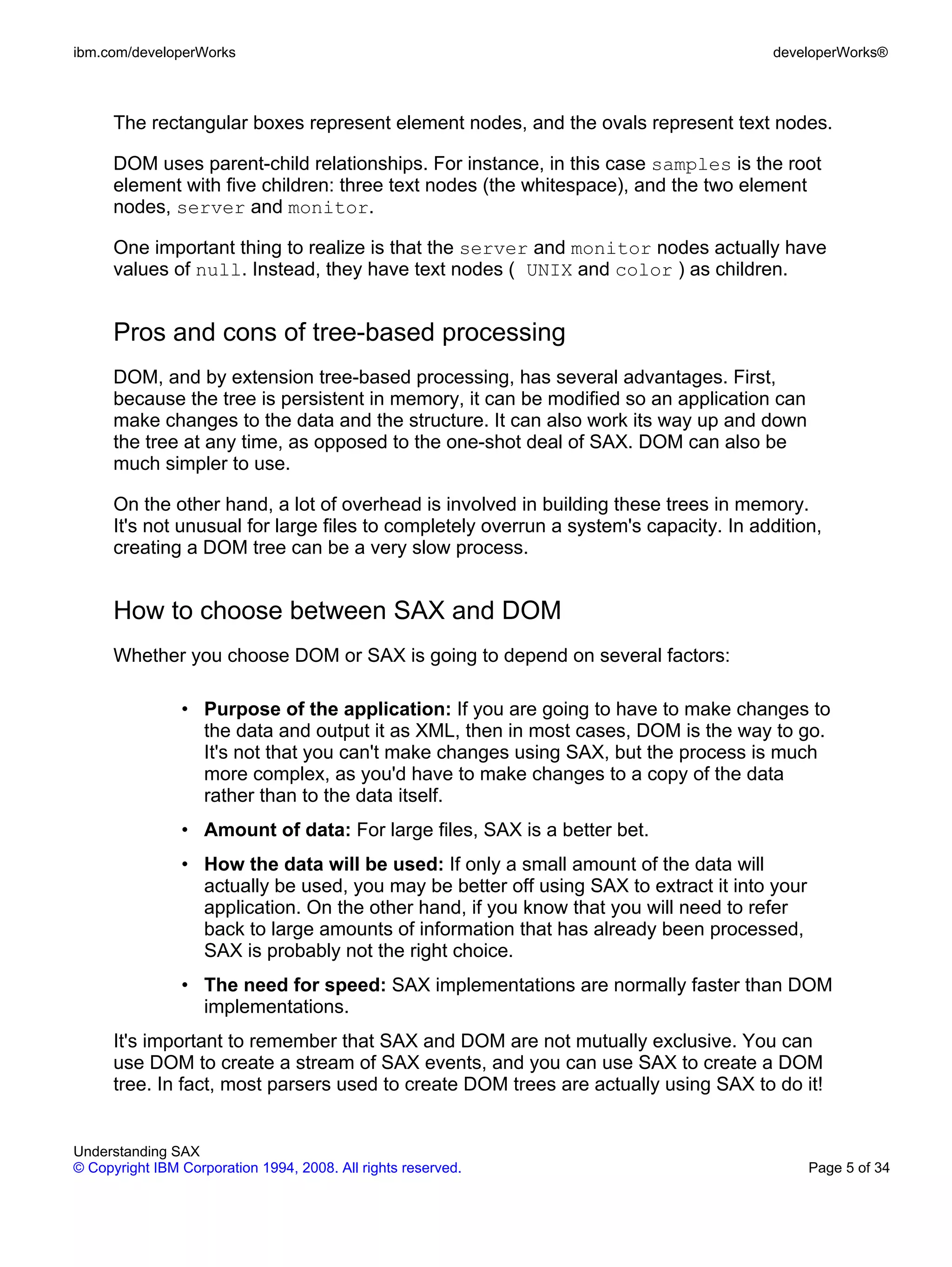

![ibm.com/developerWorks developerWorks®
<question subject="inside">D</question>
<question subject="implant">B</question>
</response>
<response username="sue">
<question subject="appearance">C</question>
<question subject="communication">A</question>
<question subject="ship">A</question>
<question subject="inside">D</question>
<question subject="implant">A</question>
</response>
<response username="carol">
<question subject="appearance">A</question>
<question subject="communication">C</question>
<question subject="ship">A</question>
<question subject="inside">D</question>
<question subject="implant">C</question>
</response>
</surveys>
Creating an event handler
Before an application can use SAX to process an XML document, it must create an
event handler. SAX provides a class, DefaultHandler, that applications can
extend.
Proper parsing using SAX requires specific calls to the handler's methods, and these
calls can't be static. This means you need to specifically instantiate the handler
object, so I'll give a quick overview of that, in case you're not used to working with
objects.
When a new object is created, it looks for any class constructors to execute. For
example:
import org.xml.sax.helpers.DefaultHandler;
public class SurveyReader extends DefaultHandler
{
public SurveyReader() {
System.out.println("Object Created.");
}
public void showEvent(String name) {
System.out.println("Hello, "+name+"!");
}
public static void main (String args[]) {
SurveyReader reader = new SurveyReader();
reader.showEvent("Nick");
}
}
When the main method executes, it creates a new instance of the SurveyReader
class. This causes the constructor to execute, outputting Object Created (along
Understanding SAX
© Copyright IBM Corporation 1994, 2008. All rights reserved. Page 7 of 34](https://image.slidesharecdn.com/x-usax-pdf-091023002320-phpapp02/75/X-Usax-Pdf-7-2048.jpg)
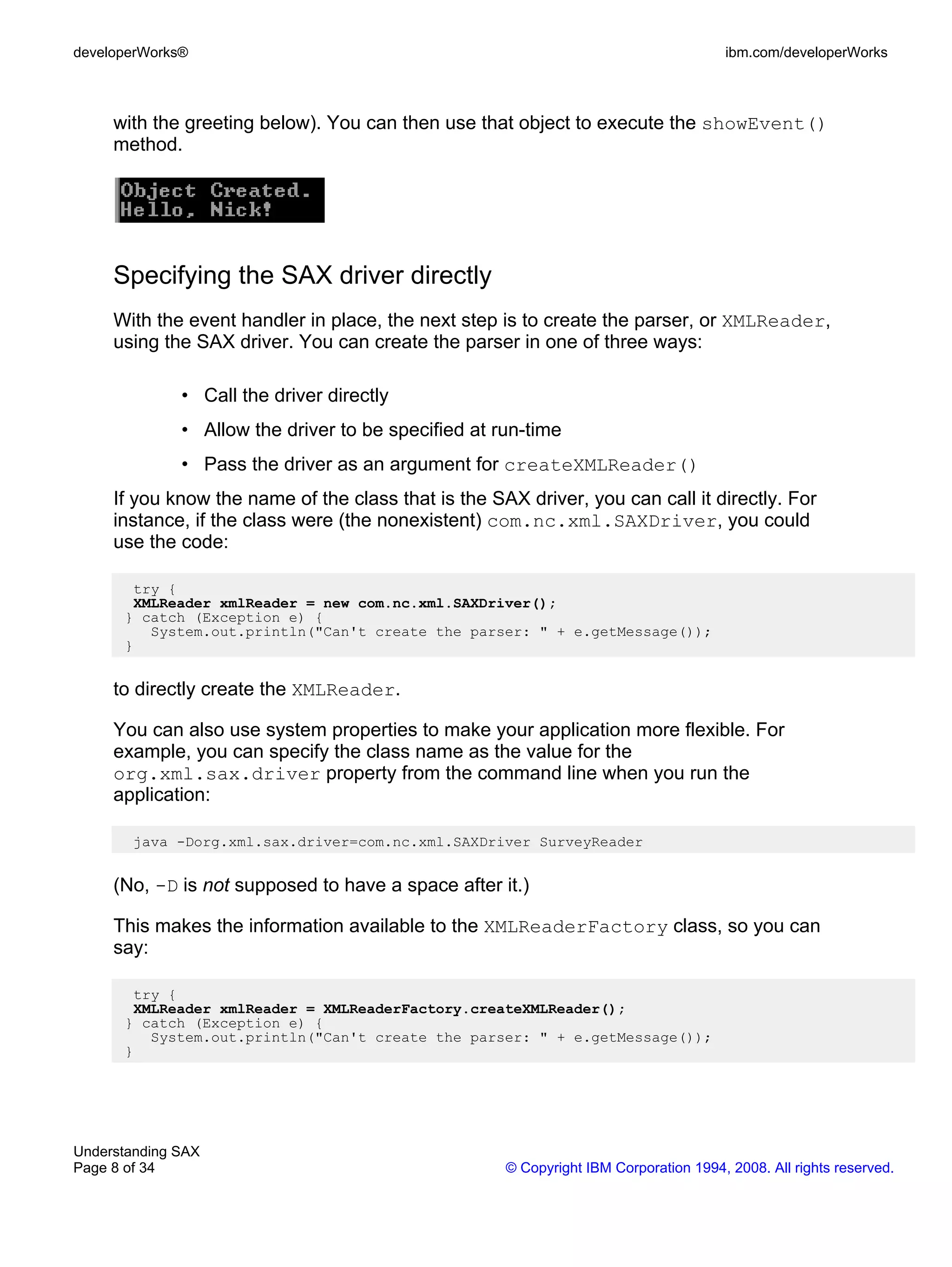
![ibm.com/developerWorks developerWorks®
If you know the driver name, you can also pass it directly as an argument for
createXMLReader().
Create the parser
This example uses a pair of classes, SAXParserFactory and SAXParser, to
create the parser, so you don't have to know the name of the driver itself.
First declare the XMLReader, xmlReader, and then use SAXParserFactory to
create a SAXParser. It's the SAXParser that gives you the XMLReader.
import org.xml.sax.helpers.DefaultHandler;
import javax.xml.parsers.SAXParser;
import javax.xml.parsers.SAXParserFactory;
import org.xml.sax.XMLReader;
public class SurveyReader extends DefaultHandler
{
public SurveyReader() {
}
public static void main (String args[]) {
XMLReader xmlReader = null;
try {
SAXParserFactory spfactory = SAXParserFactory.newInstance();
SAXParser saxParser = spfactory.newSAXParser();
xmlReader = saxParser.getXMLReader();
} catch (Exception e) {
System.err.println(e);
System.exit(1);
}
}
}
Validating versus non-validating parsers
To do anything with an XML document, you have to read the information in it. The
application that does this is called a parser.
The two kinds of parsers are: non-validating and validating.
• A non-validating parser is satisfied if the file is well-formed. It takes each
unit of information and adds it to the document -- or in the case of a SAX
application, processes the event -- without regard for the actual structure
Understanding SAX
© Copyright IBM Corporation 1994, 2008. All rights reserved. Page 9 of 34](https://image.slidesharecdn.com/x-usax-pdf-091023002320-phpapp02/75/X-Usax-Pdf-9-2048.jpg)
![developerWorks® ibm.com/developerWorks
or content.
• A validating parser, on the other hand, checks the content and structure
of an XML document against a defined grammar. Sometimes this
grammar is in the form of a Document Type Definition (DTD), but these
days it's more likely to be defined in an XML Schema document. In either
case, the parser checks the document to make sure that each element
and attribute is defined and contains the proper types of content. For
instance, you might specify that every order must have a status. If you
tried to create one without it, a validating parser would signal a problem.
Documents that have been verified by a validating parser are said to be valid
documents.
Set validation options
For this tutorial, you're not validating the survey results, so turn off validation for any
parser the SAXParserFactory creates by setting the validating property:
...
public static void main (String args[]) {
XMLReader xmlReader = null;
try {
SAXParserFactory spfactory =
SAXParserFactory.newInstance();
spfactory.setValidating(false);
SAXParser saxParser =
spfactory.newSAXParser();
xmlReader = saxParser.getXMLReader();
} catch (Exception e) {
System.err.println(e);
System.exit(1);
}
}
...
Set the content handler
The parser has to send its events to a ContentHandler. To keep things simple,
SurveyReader is both the main application and the content handler, so create a
new instance of it and set it as the ContentHandler using the XMLReader 's
setContentHandler() method:
...
Understanding SAX
Page 10 of 34 © Copyright IBM Corporation 1994, 2008. All rights reserved.](https://image.slidesharecdn.com/x-usax-pdf-091023002320-phpapp02/75/X-Usax-Pdf-10-2048.jpg)
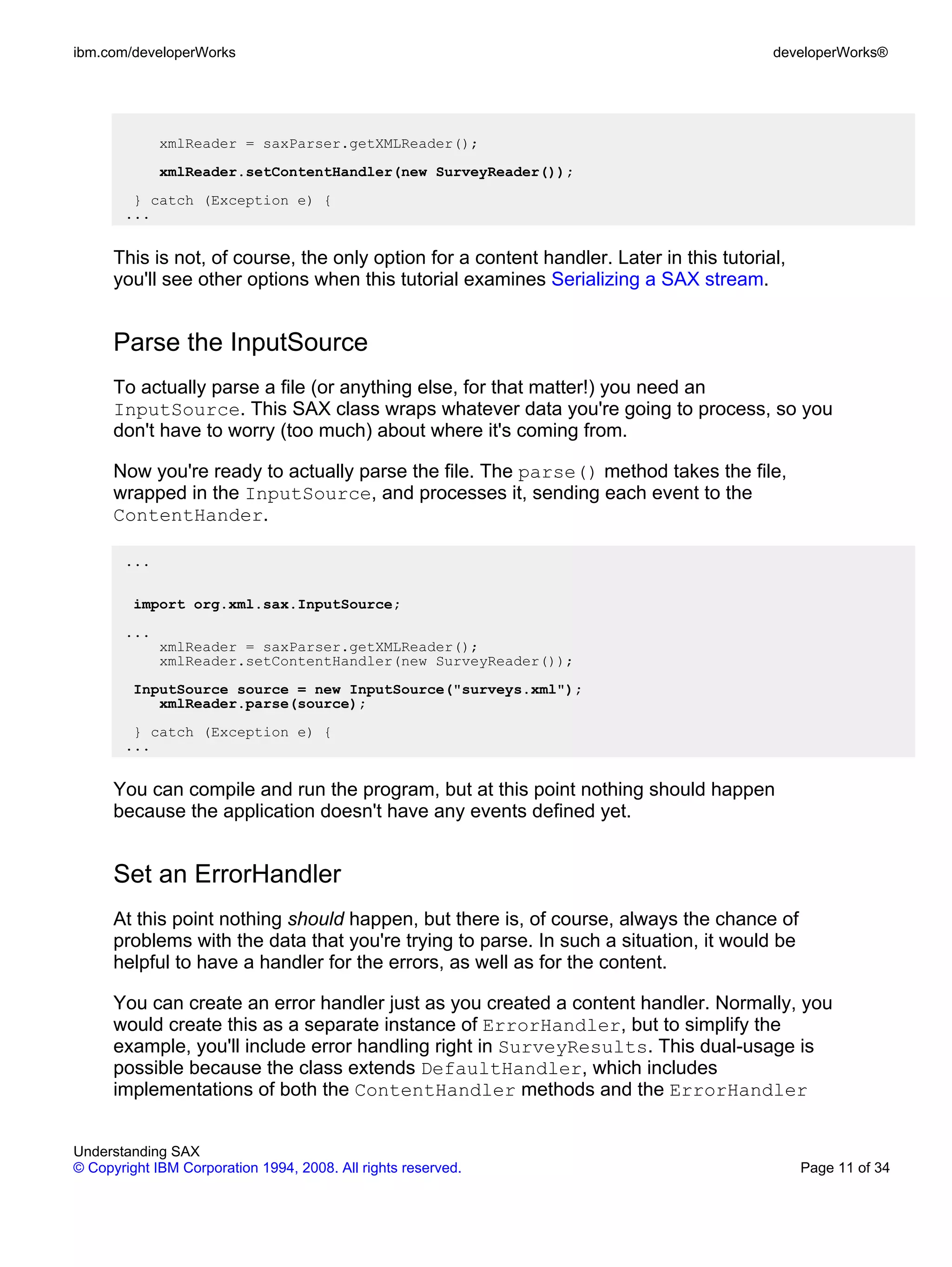
![developerWorks® ibm.com/developerWorks
methods.
Set a new ErrorHandler just as you set the ContentHandler:
...
xmlReader.setContentHandler(new SurveyReader());
xmlReader.setErrorHandler(new SurveyReader());
InputSource source = new InputSource("surveys.xml");
...
Still, nothing should happen if you run the application because the default
implementations for each event don't do anything. In the next section, I'll look at
adding new implementations to handle the events that occur during parsing.
Section 4. Event handlers and the SAX events
startDocument()
Now that you're set up to parse the document, it's time to start replacing the default
implementations that are part of the DefaultHandler class with methods that
actually do something when the handler receives the appropriate event.
Start by noting the beginning of the document using the startDocument() event.
This event, like the other SAX events, throws a SAXException:
...
import org.xml.sax.SAXException;
public class SurveyReader extends DefaultHandler
{
public SurveyReader() {
}
public void startDocument() throws SAXException {
System.out.println("Tallying survey results...");
}
public static void main (String args[]) {
XMLReader xmlReader = null;
...
Understanding SAX
Page 12 of 34 © Copyright IBM Corporation 1994, 2008. All rights reserved.](https://image.slidesharecdn.com/x-usax-pdf-091023002320-phpapp02/75/X-Usax-Pdf-12-2048.jpg)
![ibm.com/developerWorks developerWorks®
startElement()
Now, begin looking at the actual data. For each element, the example echoes back
the name that is passed to the startElement() event (see the Element Listing
screenshot below).
The parser actually passes several pieces of information for each element:
• The qualified name, or qName. This is actually a combination of
namespace information, if any, and the actual name of the element. The
qName also includes the colon (: ) if there is one -- for example,
revised:response.
• The namespace URI. As discussed in Namespaces, an actual
namespace is a URI of some sort and not the alias that gets added to an
element or attribute name. For example,
http://www.nicholaschase.com/surveys/revised/ as opposed
to simply revised:.
• The local name. This is the actual name of the element, such as
question. If the document doesn't provide namespace information, the
parser may not be able to determine which part of the qName is the
localName.
• Any attributes. The attributes for an element are actually passed as a
collection of objects, as seen in the next panel.
Start by listing the name of each element:
...
import org.xml.sax.Attributes;
public class SurveyReader extends DefaultHandler
{
...
public void startDocument() throws SAXException {
System.out.println("Tallying survey results...");
}
public void startElement(String namespaceURI, String localName,
String qName, Attributes atts) throws SAXException {
System.out.print("Start element: ");
System.out.println(qName);
}
public static void main (String args[]) {
Understanding SAX
© Copyright IBM Corporation 1994, 2008. All rights reserved. Page 13 of 34](https://image.slidesharecdn.com/x-usax-pdf-091023002320-phpapp02/75/X-Usax-Pdf-13-2048.jpg)

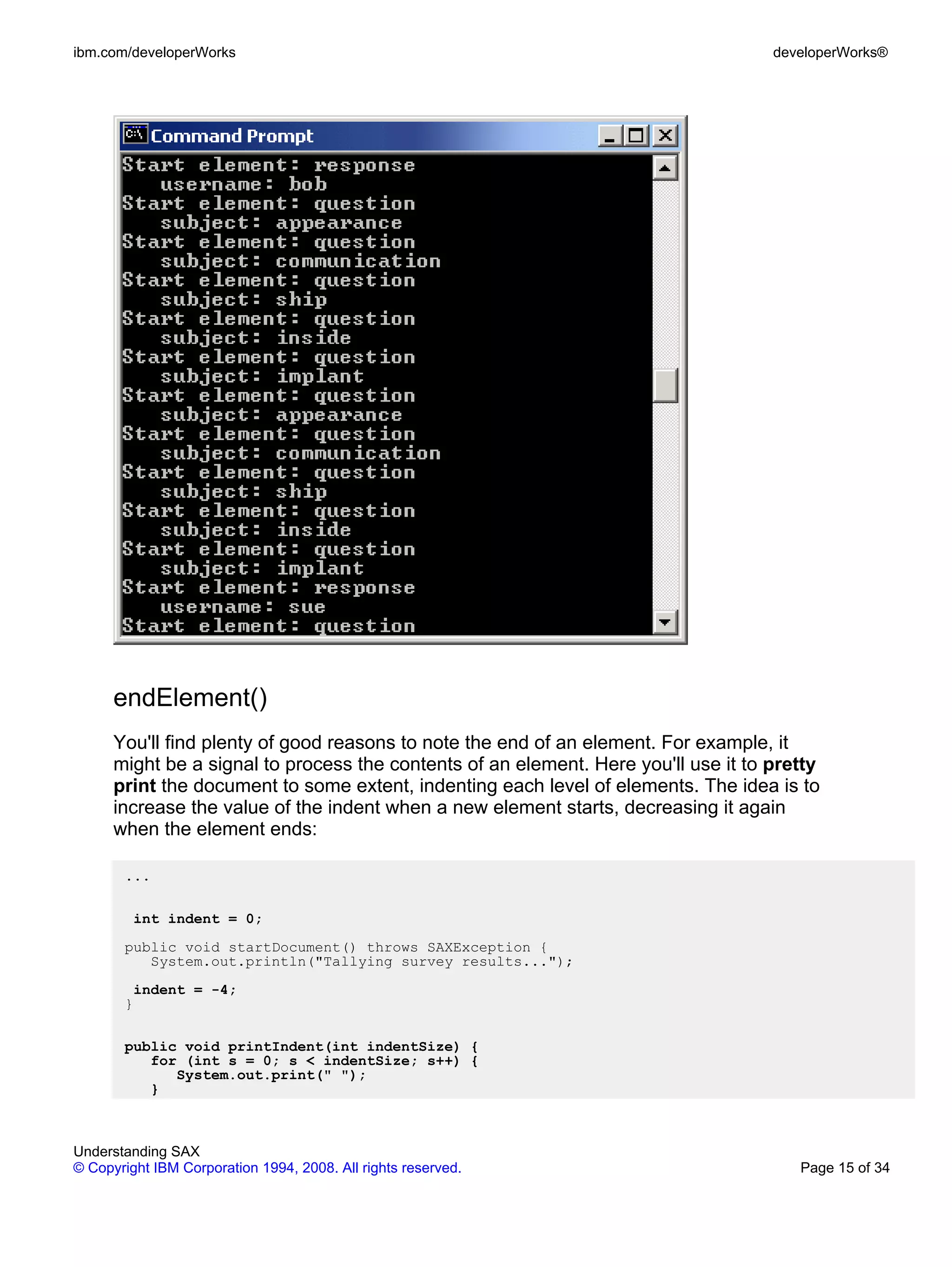
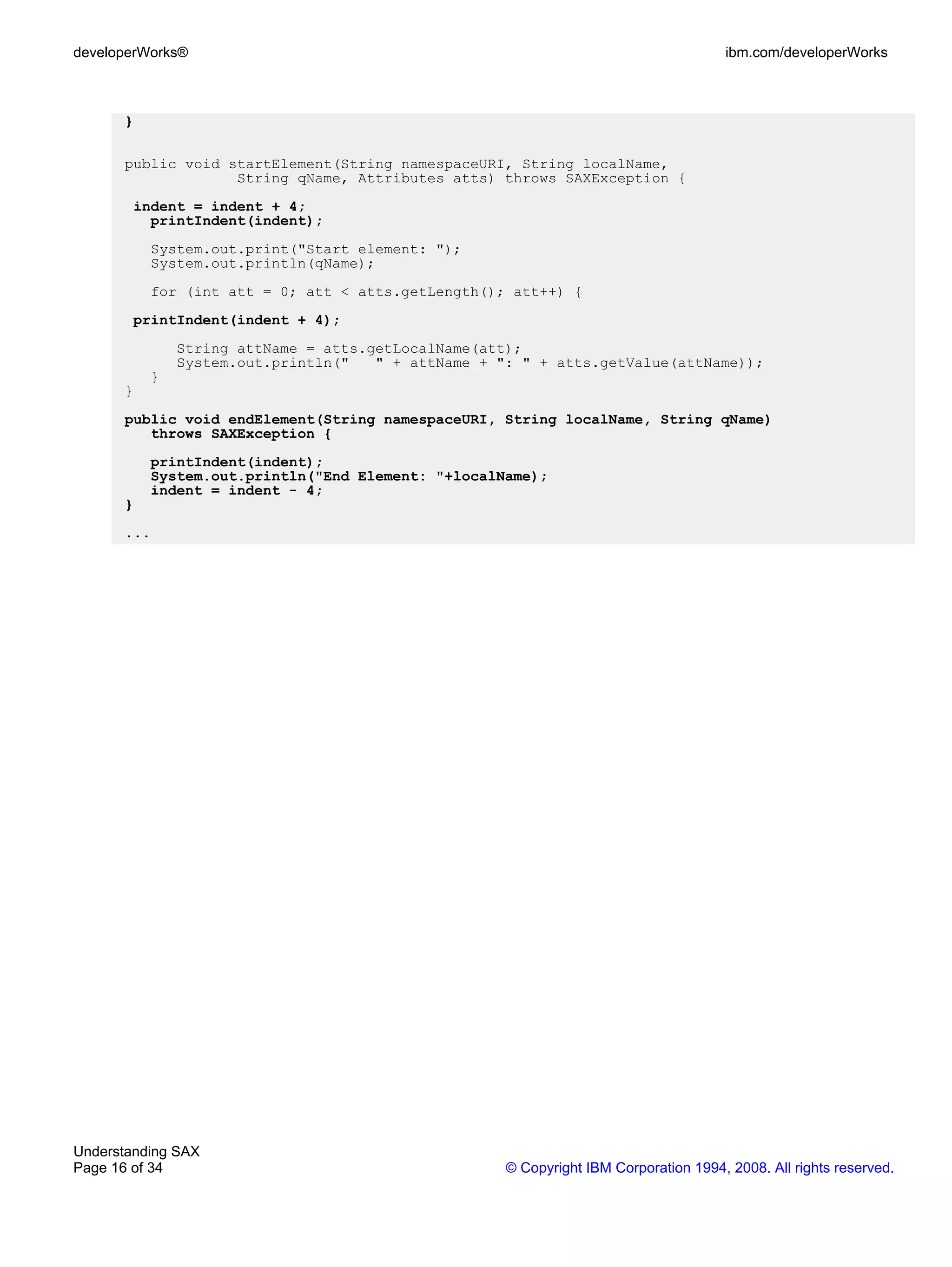
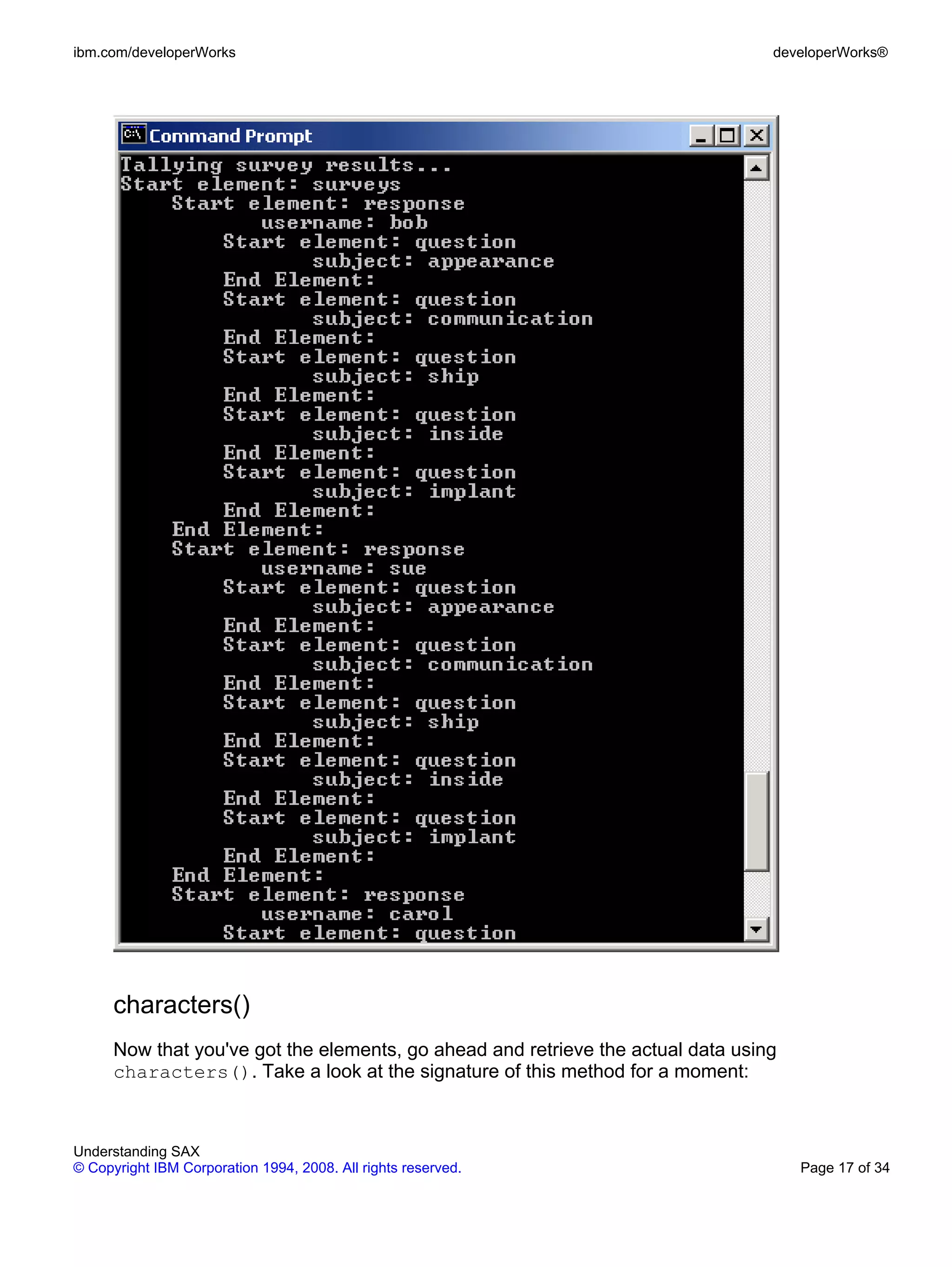
![developerWorks® ibm.com/developerWorks
public void characters(char[] ch,
int start,
int length)
throws SAXException
Notice that nowhere in this method is there any information whatsoever as to what
element these characters are part of. If you need this information, you're going to
have to store it. This example adds variables to store the current element and
question information. (It also removes a lot of extraneous information that was
displayed.)
Note two important things here:
• Range: The characters() event includes more than just a string of
characters. It also includes start and length information. In actuality, the
ch character array includes the entire document. The application must not
attempt to read characters outside the range the event feeds to the
characters() event.
• Frequency: Nothing in the SAX specification requires a processor to
return characters in any particular way, so it's possible for a single chunk
of text to be returned in several pieces. Always make sure that the
endElement() event has occurred before assuming you have all the
content of an element. Also, processors may use ignorableWhitespace()
to return whitespace within an element. This is always the case for a
validating parser.
...
public void printIndent(int indentSize) {
for (int s = 0; s < indentSize; s++) {
System.out.print(" ");
}
}
String thisQuestion = "";
String thisElement = "";
public void startElement(String namespaceURI, String localName,
String qName, Attributes atts) throws SAXException {
if (qName == "response") {
System.out.println("User: " + atts.getValue("username"));
} else if (qName == "question") {
thisQuestion = atts.getValue("subject");
}
thisElement = qName;
}
public void endElement(String namespaceURI, String localName, String qName)
throws SAXException {
thisQuestion = "";
thisElement = "";
Understanding SAX
Page 18 of 34 © Copyright IBM Corporation 1994, 2008. All rights reserved.](https://image.slidesharecdn.com/x-usax-pdf-091023002320-phpapp02/75/X-Usax-Pdf-18-2048.jpg)
![ibm.com/developerWorks developerWorks®
}
public void characters(char[] ch, int start, int length)
throws SAXException {
if (thisElement == "question") {
printIndent(4);
System.out.print(thisQuestion + ": ");
System.out.println(new String(ch, start, length));
}
}
...
Record the answers
Now that you've got the data, go ahead and add the actual tally.
This is as simple as building strings for analysis when the survey is complete.
...
String appearance = null;
String communication = null;
String ship = null;
String inside = null;
String implant = null;
public void characters(char[] ch,
int start,
int length)
throws SAXException {
if (thisElement == "question") {
Understanding SAX
© Copyright IBM Corporation 1994, 2008. All rights reserved. Page 19 of 34](https://image.slidesharecdn.com/x-usax-pdf-091023002320-phpapp02/75/X-Usax-Pdf-19-2048.jpg)
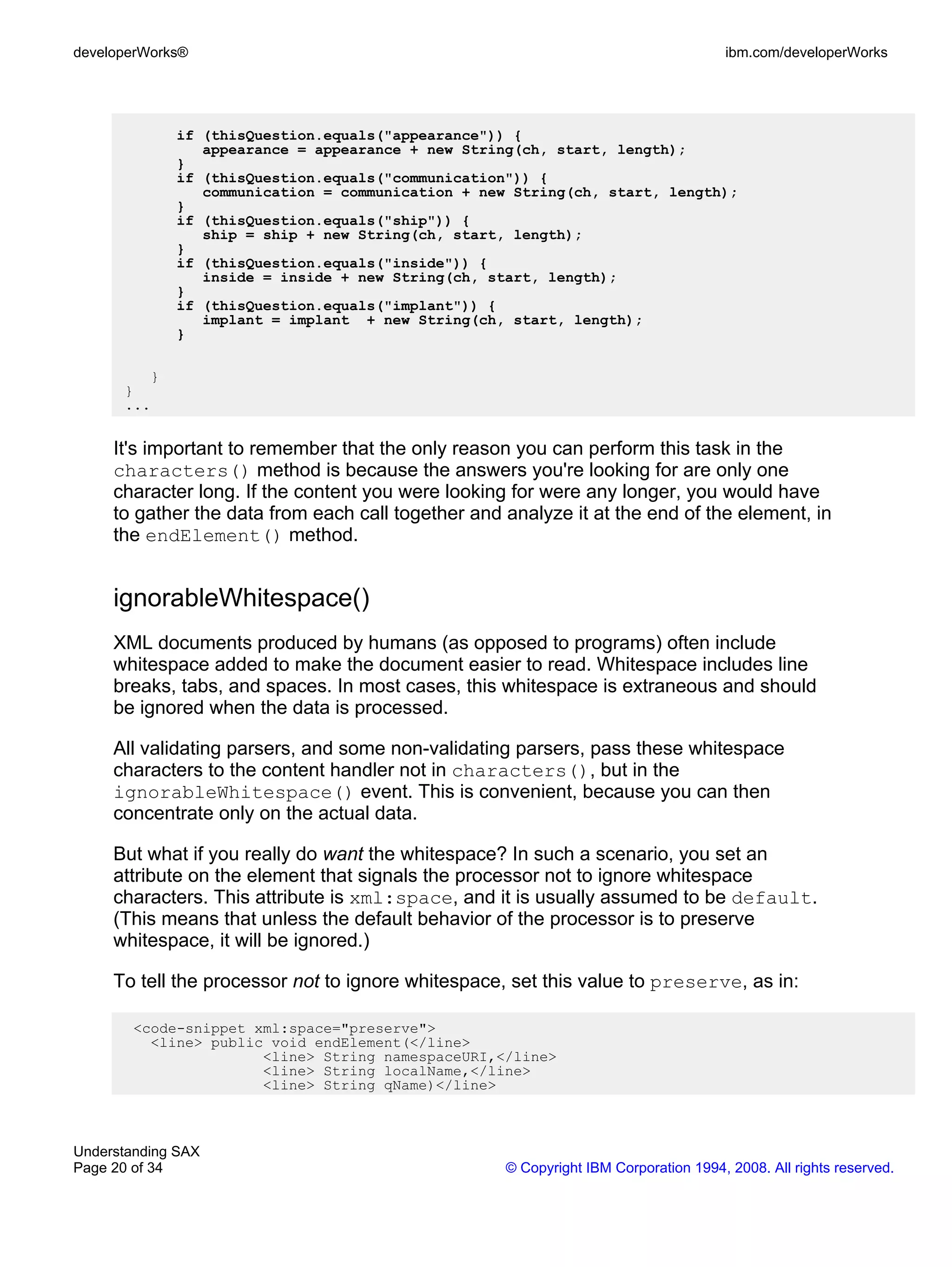
![ibm.com/developerWorks developerWorks®
<line> throws SAXException</line>
</code-snippet>
endDocument()
And of course, once the document is completely parsed, you'll want to print out the
final tally as shown below.
This is also a good place to tie up any loose ends that may have come up during
processing.
...
if (thisQuestion.equals("implant")) {
implant = implant + new String(ch, start, length);
}
}
}
public int getInstances (String all,
String choice) {
...
return total;
}
public void endDocument() {
System.out.println("Appearance of the aliens:");
System.out.println("A: " + getInstances(appearance, "A"));
System.out.println("B: " + getInstances(appearance, "B"));
...
}
public static void main (String args[]) {
...
Understanding SAX
© Copyright IBM Corporation 1994, 2008. All rights reserved. Page 21 of 34](https://image.slidesharecdn.com/x-usax-pdf-091023002320-phpapp02/75/X-Usax-Pdf-21-2048.jpg)
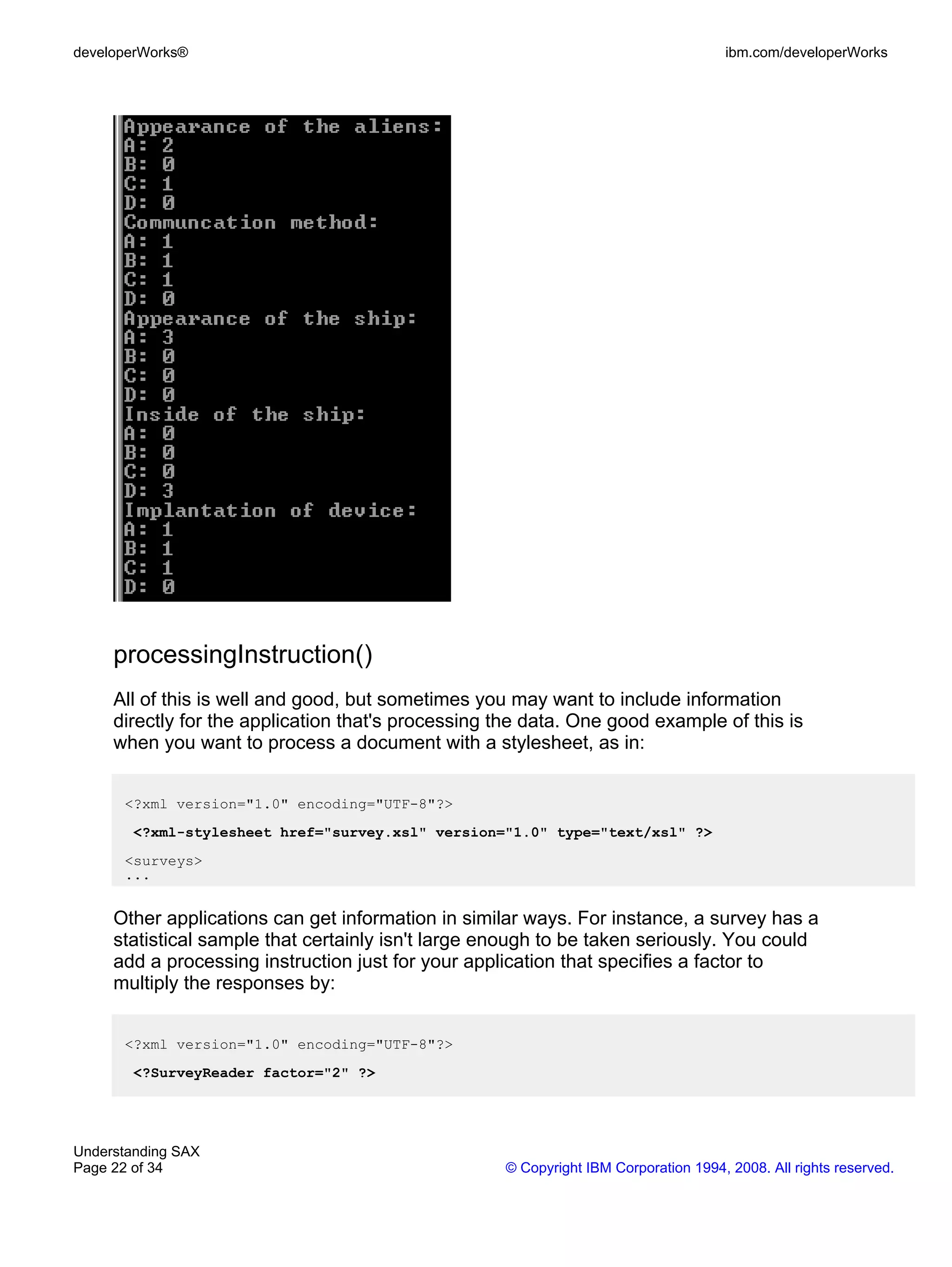
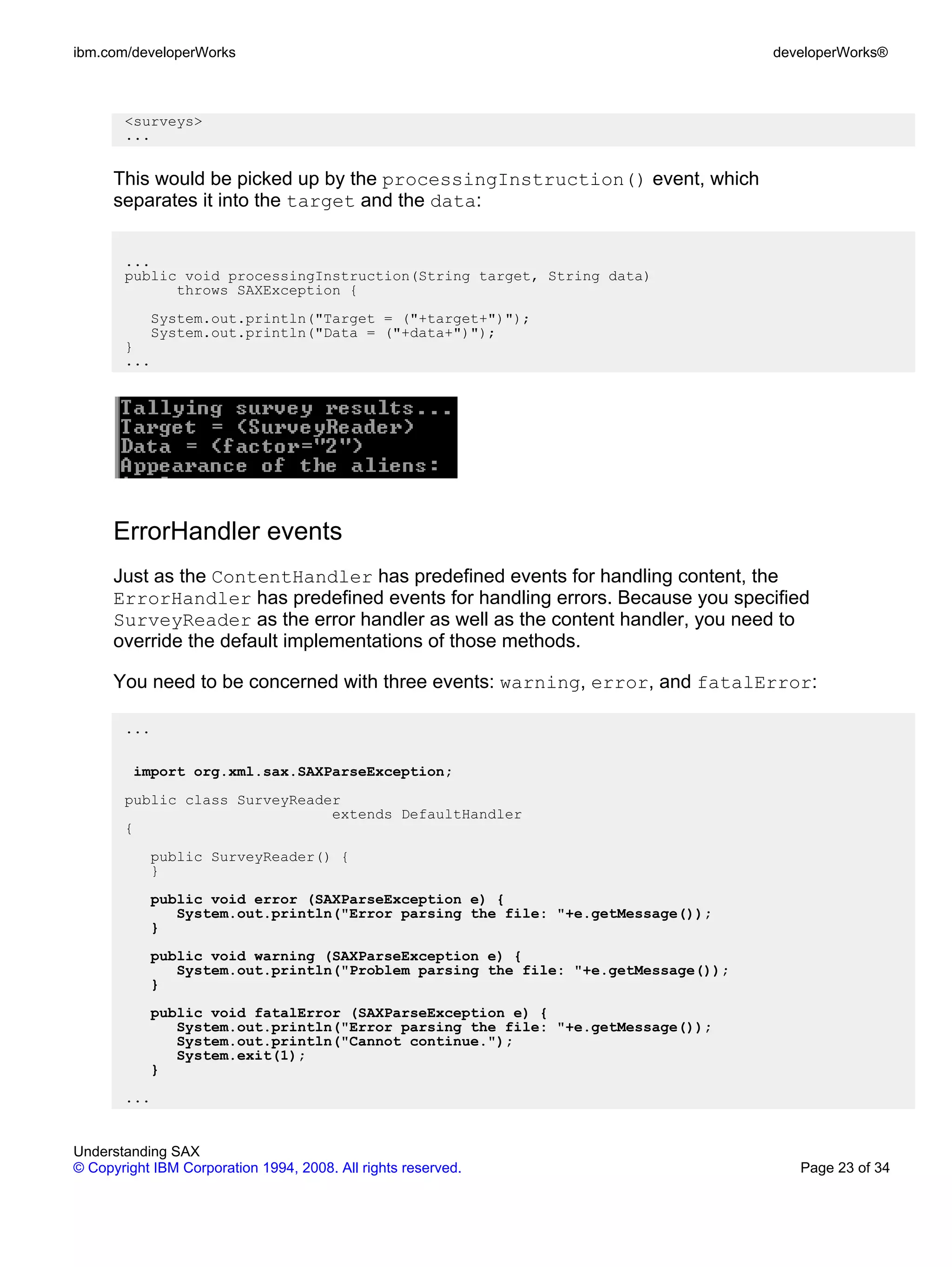
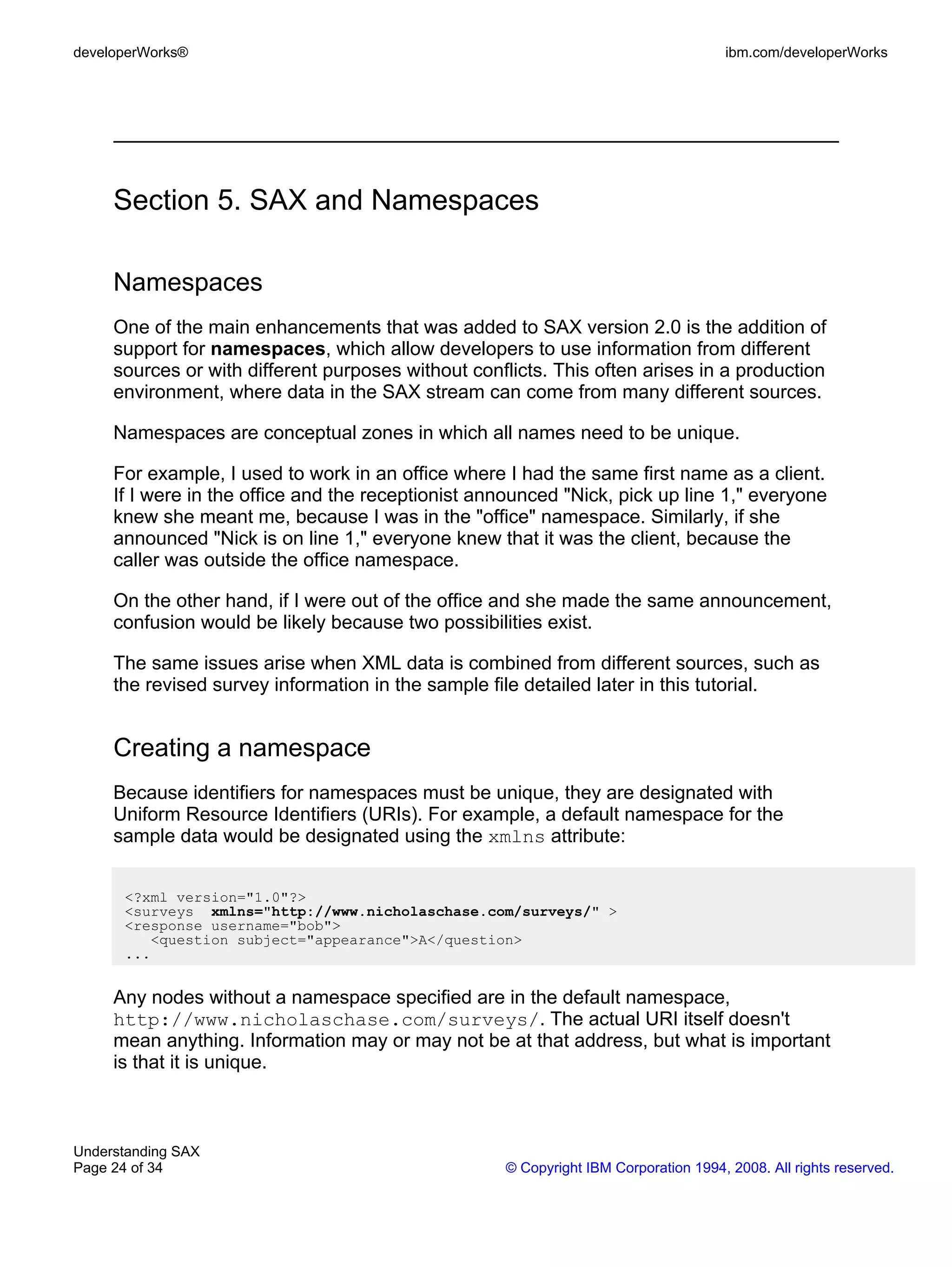
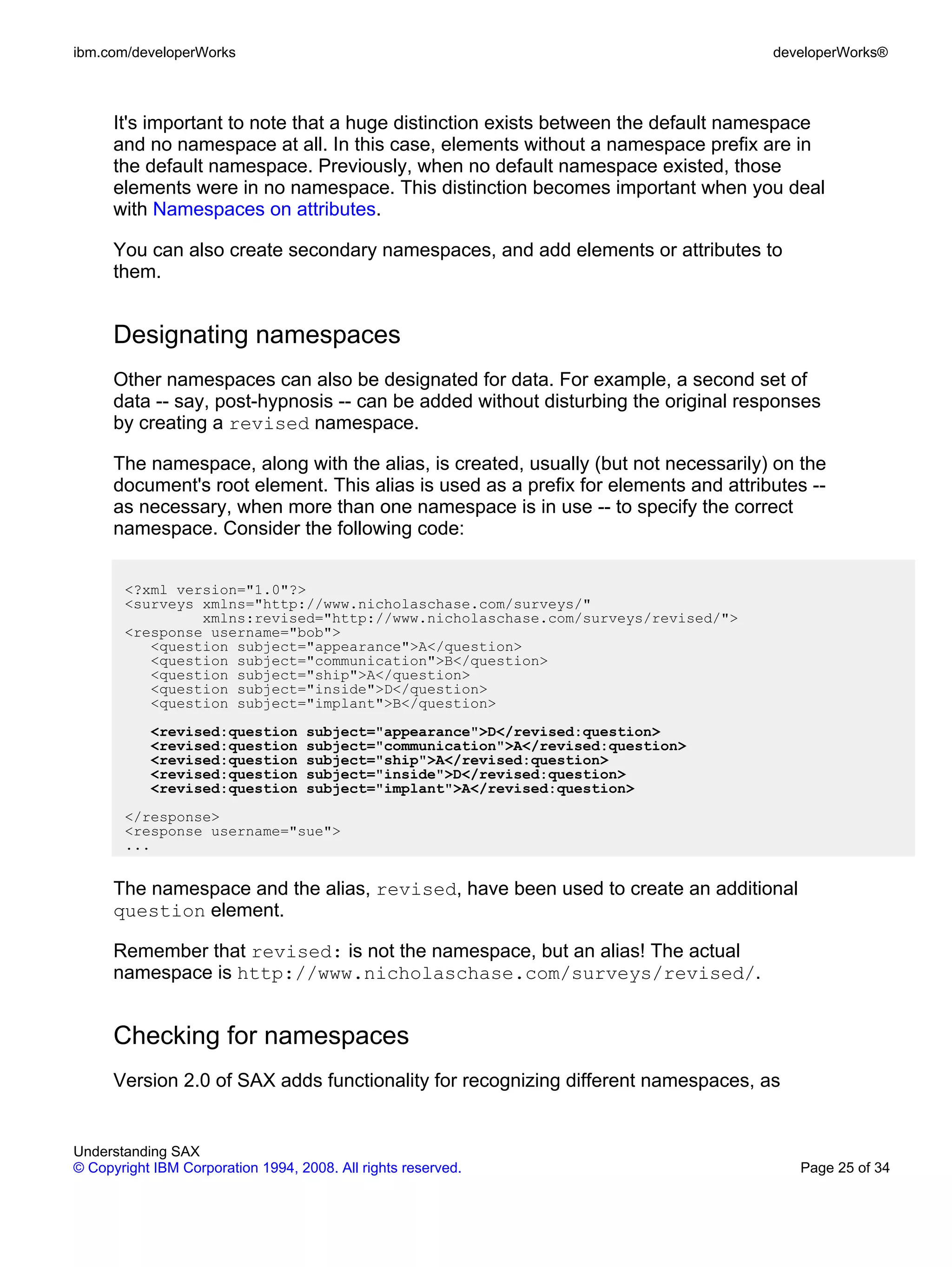
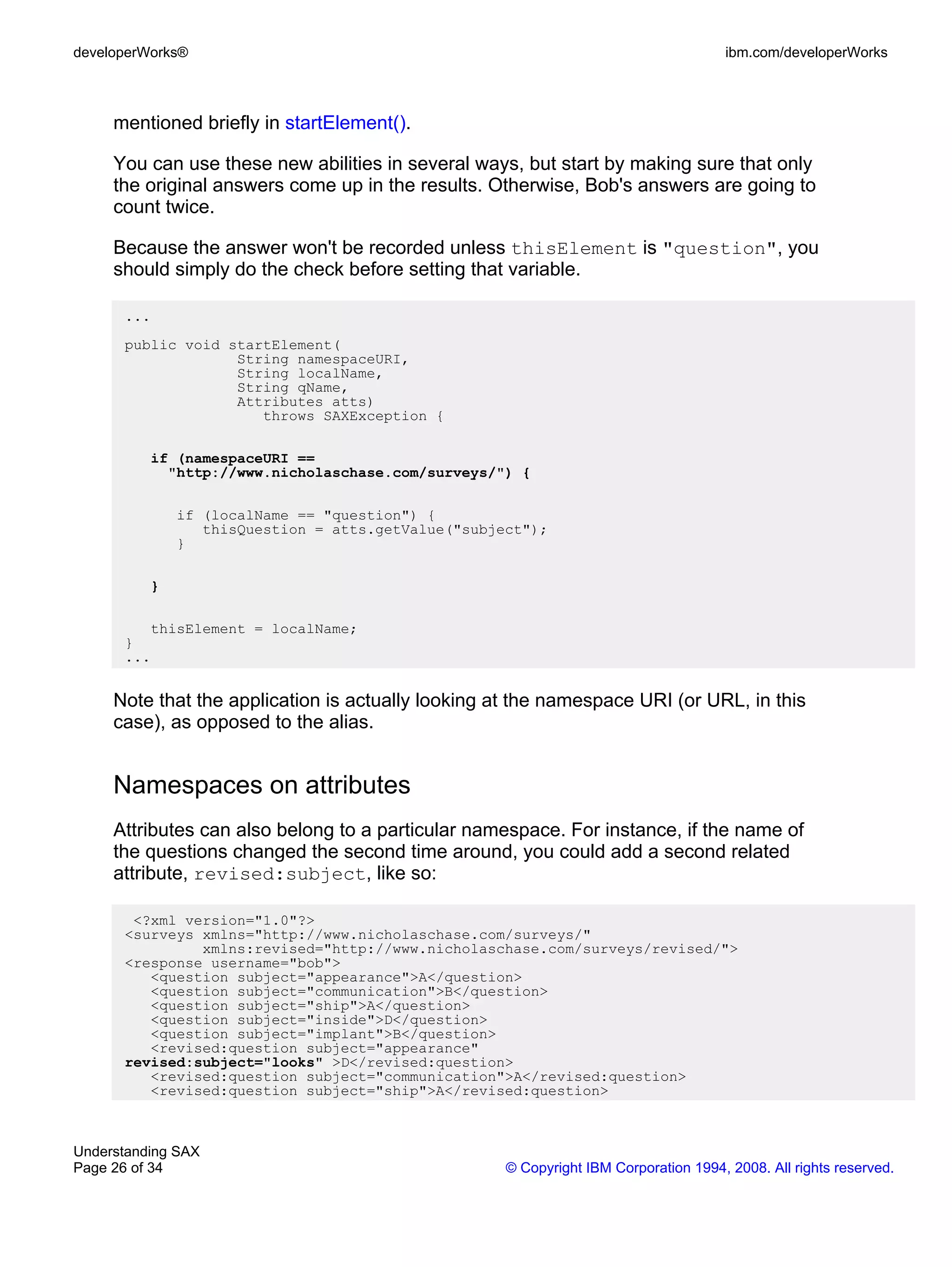
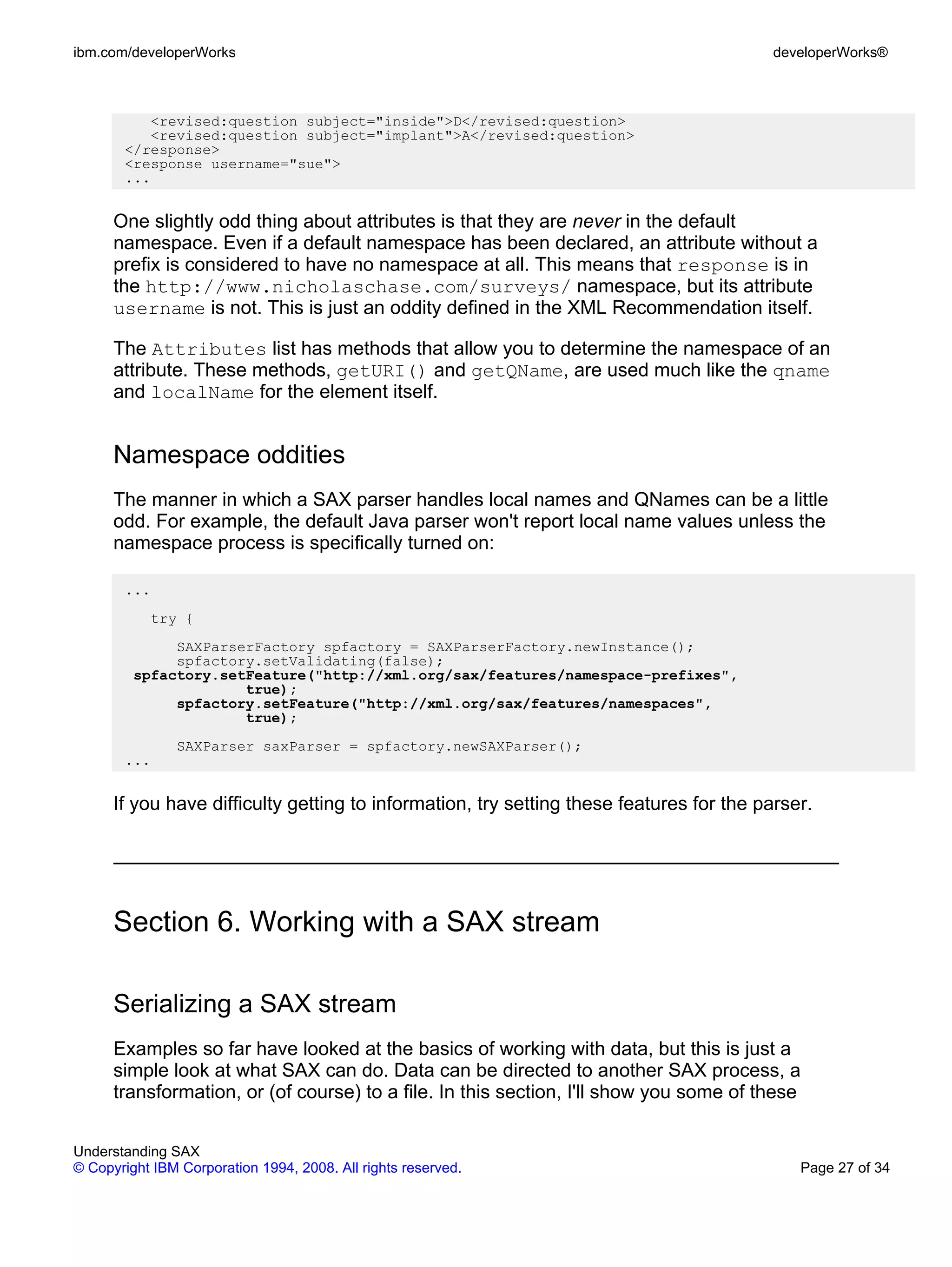
![developerWorks® ibm.com/developerWorks
options.
Outputting the stream of SAX events to a file is called serializing it. You can write
the file yourself, but it's so much easier to simply use the Serializer object:
import org.apache.xalan.serialize.Serializer;
import org.apache.xalan.serialize.SerializerFactory;
import org.apache.xalan.templates.OutputProperties;
import java.io.FileOutputStream;
...
public static void main (String args[]) {
XMLReader xmlReader = null;
try {
SAXParserFactory spfactory = SAXParserFactory.newInstance();
spfactory.setValidating(false);
SAXParser saxParser = spfactory.newSAXParser();
xmlReader = saxParser.getXMLReader();
Serializer serializer = SerializerFactory.getSerializer(
OutputProperties.getDefaultMethodProperties("xml"));
serializer.setOutputStream(new FileOutputStream("output.xml"));
xmlReader.setContentHandler(
serializer.asContentHandler()
);
InputSource source = new InputSource("surveys.xml");
xmlReader.parse(source);
} catch (Exception e) {
System.err.println(e);
System.exit(1);
}
}
...
Create the Serializer object -- acceptable values for the OutputProperties
are xml, text, and html -- and set its OutputStream. This stream can be virtually
any stream-type object, such as a file (as it is here) or System.out.
You can then set the Serializer as the content handler for the parser, so when
the parser parses the file, it's the Serializer that receives the events.
XMLFilters
Because SAX involves analyzing data (as opposed to storing it) as it passes by, you
may think that there's no way to alter the data before it's analyzed.
This is the problem that XMLFilter s solve. Although they're new to version 2.0 of
SAX, they were actually in use in version 1.0 by clever programmers who realized
that they could "chain" SAX streams together, effectively manipulating them before
Understanding SAX
Page 28 of 34 © Copyright IBM Corporation 1994, 2008. All rights reserved.](https://image.slidesharecdn.com/x-usax-pdf-091023002320-phpapp02/75/X-Usax-Pdf-28-2048.jpg)
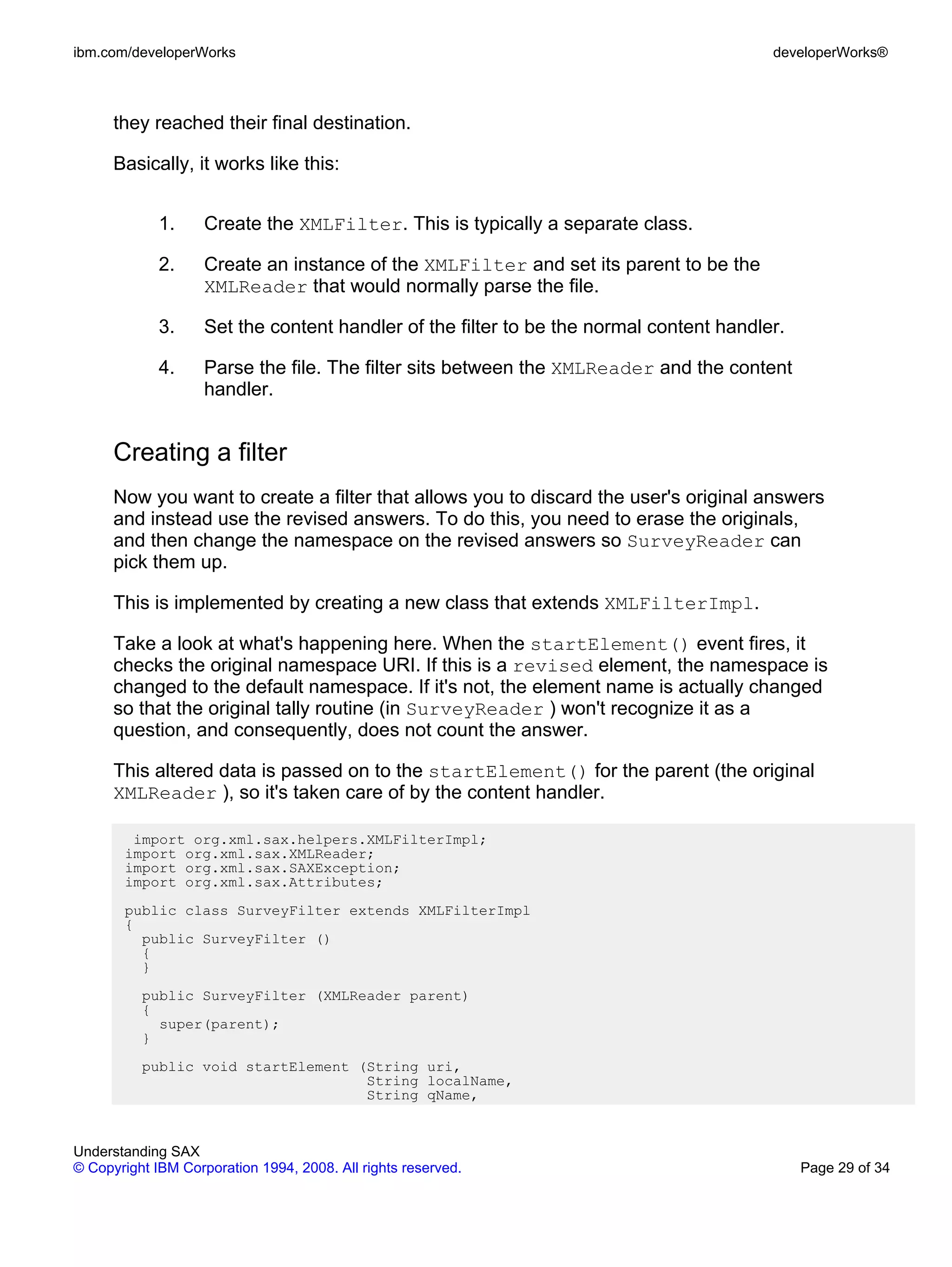
![developerWorks® ibm.com/developerWorks
Attributes atts)
throws SAXException
{
if (uri == "http://www.nicholaschase.com/surveys/revised/") {
uri = "http://www.nicholaschase.com/surveys/";
qName = "question";
} else {
localName = "REJECT";
}
super.startElement(uri, localName, qName, atts);
}
}
Invoking the filter
Now it's time to use the filter. The first thing to do is create a new instance, then
assign the original XMLReader as its parent.
Next, set the content and error handlers on the filter, as opposed to the reader.
Finally, use the filter to parse the file, instead of the XMLReader.
Because the XMLReader is designated as the filter's parent, it still processes the
information.
...
public static void main (String args[]) {
XMLReader xmlReader = null;
try {
SAXParserFactory spfactory =
SAXParserFactory.newInstance();
spfactory.setValidating(false);
SAXParser saxParser =
spfactory.newSAXParser();
xmlReader = saxParser.getXMLReader();
SurveyFilter xmlFilter = new SurveyFilter();
xmlFilter.setParent(xmlReader);
xmlFilter.
setContentHandler(new SurveyReader());
xmlFilter.
setErrorHandler(new SurveyReader());
InputSource source = new InputSource("surveys.xml");
xmlFilter.
parse(source);
} catch (Exception e) {
System.err.println(e);
System.exit(1);
Understanding SAX
Page 30 of 34 © Copyright IBM Corporation 1994, 2008. All rights reserved.](https://image.slidesharecdn.com/x-usax-pdf-091023002320-phpapp02/75/X-Usax-Pdf-30-2048.jpg)
![ibm.com/developerWorks developerWorks®
}
}
...
The depth of nesting for these features is unlimited. Theoretically, you could create a
long chain of filters, each one calling the next.
Using an XMLFilter to transform data
XMLFilters can also be used to quickly and easily transform data using XSLT.
The transformation itself is beyond the scope of this tutorial, but here's a quick look
at how you would apply it:
import javax.xml.transform.stream.StreamSource;
import javax.xml.transform.Transformer;
import javax.xml.transform.TransformerFactory;
import javax.xml.transform.sax.SAXTransformerFactory;
import org.xml.sax.XMLFilter;
...
public static void main (String args[]) {
XMLReader xmlReader = null;
try {
SAXParserFactory spfactory = SAXParserFactory.newInstance();
spfactory.setValidating(false);
SAXParser saxParser = spfactory.newSAXParser();
xmlReader = saxParser.getXMLReader();
TransformerFactory tFactory = TransformerFactory.newInstance();
SAXTransformerFactory
saxTFactory = ((SAXTransformerFactory) tFactory);
XMLFilter xmlFilter =
saxTFactory.newXMLFilter(new StreamSource("surveys.xsl"));
xmlFilter.setParent(xmlReader);
Serializer serializer =
SerializerFactory.getSerializer(
OutputProperties.getDefaultMethodProperties("xml"));
serializer.setOutputStream(System.out);
xmlFilter.setContentHandler(
serializer.asContentHandler() );
InputSource source = new InputSource("surveys.xml");
xmlFilter.parse(source);
} catch (Exception e) {
System.err.println(e);
System.exit(1);
}
}
...
Understanding SAX
© Copyright IBM Corporation 1994, 2008. All rights reserved. Page 31 of 34](https://image.slidesharecdn.com/x-usax-pdf-091023002320-phpapp02/75/X-Usax-Pdf-31-2048.jpg)
